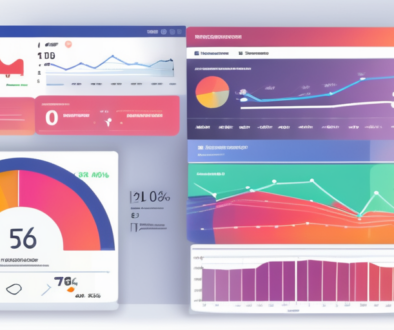Banner Ads and Native Ads: How Do They Differ?
Online advertising is a critical component of any marketing strategy in today’s digital world. Two common forms of online advertising are banner ads and native ads. While both serve the purpose of promoting products or services, they differ significantly in their approach. Understanding the differences between banner ads and native ads can help businesses choose the most suitable advertising strategy for their needs.
Understanding the Basics of Online Advertising
Defining Banner Ads
First, let’s define what banner ads are. Banner ads are graphical advertisements displayed on websites. They usually appear at the top, bottom, or along the sides of a webpage. These ads are designed to catch users’ attention and encourage them to click through to the advertiser’s website.
In most cases, banner ads are static or animated images with a call-to-action button or a hyperlink embedded within them. The visual elements, color schemes, and texts can vary depending on the advertiser’s preferences and branding requirements.
Moreover, banner ads come in various sizes, such as leaderboard (728×90 pixels), skyscraper (160×600 pixels), and rectangle (300×250 pixels), allowing advertisers to choose the format that best suits their marketing goals and target audience. These ads can be created using tools like Adobe Photoshop or Canva, ensuring a visually appealing and engaging design that resonates with users.
Defining Native Ads
On the other hand, native ads are designed to blend seamlessly with the content of the website or platform on which they appear. These ads match the overall design, look, and feel of the website, making them appear less intrusive compared to banner ads.
Native ads are often presented as sponsored content or recommendations within articles, social media feeds, or search engine results. They appear to be part of the organic content, offering valuable information to the users without explicitly promoting a product or service.
Furthermore, native ads can take various forms, including in-feed ads that appear in social media feeds, promoted listings on e-commerce platforms, and recommended articles on news websites. By integrating seamlessly with the user experience, native ads have been found to drive higher engagement and click-through rates compared to traditional display ads, making them a popular choice for advertisers looking to connect with their target audience in a more subtle and effective manner.
The Key Differences Between Banner and Native Ads
Visual Appearance and Placement
One of the major differences between banner ads and native ads lies in their visual appearance and placement. Banner ads are often more visually striking and eye-catching. They use bold colors, attention-grabbing images, and animations to capture users’ attention.
Native ads, on the other hand, blend in with the surrounding content, mimicking the overall design of the webpage or platform. They are intended to provide a seamless and non-disruptive user experience. Native ads are often less visually overwhelming compared to banner ads.
In terms of placement, banner ads are typically displayed within predetermined spots on a webpage, such as the header, footer, or sidebar. Native ads, however, can be scattered throughout the content, appearing within the flow of articles or social media feeds.
User Interaction and Engagement
When it comes to user interaction and engagement, banner ads typically rely on click-through rates to measure effectiveness. These ads encourage users to click on them to redirect to the advertiser’s landing page or website.
Native ads, on the other hand, focus on providing valuable content that seamlessly integrates with the users’ browsing experience. They aim to capture users’ attention without interrupting their engagement with the content they are consuming. Native ads often seek to generate brand awareness and engagement rather than direct click-throughs.
For example, a native ad on a travel website may provide a sponsored article about the top destinations to visit in a particular country. The article would blend in with the other travel-related content on the site, offering valuable information to the users while subtly promoting a travel agency or hotel chain.
This approach allows users to engage with the content and build a positive association with the brand, even if they don’t click on the ad itself. It creates a more organic and immersive advertising experience.
Cost and ROI Considerations
Another important consideration when comparing banner ads and native ads is their cost and return on investment (ROI). Banner ads are often priced on a cost-per-thousand-impressions (CPM) basis or cost-per-click (CPC) basis, which can be more affordable for businesses with a limited budget.
Native ads, however, tend to be more expensive due to the additional effort required to create custom content that seamlessly integrates with the platform. However, studies have shown that native ads can have a higher click-through rate and long-term brand awareness, potentially delivering a higher ROI than banner ads.
When evaluating the cost and ROI of native ads, it is important to consider the long-term benefits they can bring. Native ads have the potential to create a lasting impression on users, as they are seamlessly integrated into the user experience. This can lead to increased brand recognition, customer loyalty, and ultimately, higher conversion rates.
Furthermore, native ads often have a higher chance of being shared by users, as they are seen as valuable content rather than intrusive advertisements. This can amplify the reach and impact of the ad, extending its lifespan beyond the initial impression.
While banner ads may offer a more immediate and measurable impact, native ads have the potential to deliver a more substantial and long-lasting return on investment.
Pros and Cons of Banner Ads
When it comes to online advertising, banner ads have been a popular choice for businesses looking to promote their products or services. One of the key advantages of banner ads is their visual appeal, which can quickly catch the attention of users as they browse websites. These ads often feature eye-catching graphics, animations, or videos that make them stand out on a webpage, increasing the likelihood of users noticing them.
Furthermore, banner ads are known for being cost-effective, making them a suitable option for businesses operating on a limited budget. Compared to other forms of advertising, such as television or print ads, banner ads typically require lower investment costs, allowing businesses to reach a wider audience without breaking the bank. This affordability factor has made banner ads a popular choice for small businesses and startups looking to increase their online visibility.
Advantages of Banner Ads
- Banner ads are visually appealing and can catch users’ attention quickly.
- These ads are usually cost-effective, especially for businesses with a limited budget.
- Banner ads can provide immediate click-throughs to the advertiser’s website or landing page.
- These ads allow for precise targeting and retargeting options to reach specific audiences.
Disadvantages of Banner Ads
- Banner ads can be seen as intrusive and disruptive, potentially leading to banner blindness.
- Users may intentionally ignore or overlook banner ads due to their frequent appearance on websites.
- The effectiveness of banner ads heavily relies on design and placement, requiring continuous optimization.
- Click-through rates for banner ads can be relatively low, resulting in a less favorable ROI compared to other advertising methods.
Pros and Cons of Native Ads
Advantages of Native Ads
- Native ads seamlessly blend with the surrounding content, resulting in a more pleasant user experience.
- These ads have the potential to generate higher engagement and increase brand exposure.
- Native ads can leverage the trust and credibility associated with the platform or website they appear on.
- These ads offer flexibility in terms of content format, allowing businesses to experiment with different approaches.
One key advantage of native ads is their ability to bypass ad blockers, which are commonly used by internet users to avoid traditional display ads. By integrating seamlessly with the website’s content, native ads are less likely to be blocked, ensuring that the message reaches the target audience effectively.
Disadvantages of Native Ads
- Creating custom content for native ads can be time-consuming and require additional resources.
- Native ads may not directly drive as many click-throughs as banner ads.
- It can be challenging to strike a balance between promotional content and informative content within native ads.
- Native ads might face regulatory concerns regarding transparency and disclosure of sponsored content.
Another disadvantage of native ads is the potential for audience confusion, as these ads are designed to mimic the look and feel of editorial content. Users may mistake sponsored content for genuine information, leading to a lack of trust in both the ad and the platform displaying it. Maintaining transparency and clearly labeling native ads as sponsored can help mitigate this risk and build credibility with the audience.
Choosing the Right Advertising Strategy for Your Business
Factors to Consider
As a business, it’s crucial to consider various factors in determining the most suitable advertising strategy.
- Target Audience: Assess your target audience’s demographics, behavior, and preferences. This information can help determine the effectiveness of banner ads or the potential impact of native ads.
- Platform and Context: Understand the platform on which you plan to advertise. Consider whether banner ads or native ads align better with the user experience and context of the platform.
- Goals and Objectives: Define your advertising goals, whether it’s driving immediate conversions or building long-term brand awareness. Different goals may call for different strategies.
Balancing Banner and Native Ads in Your Strategy
Rather than choosing between banner ads and native ads, many businesses find success in integrating both strategies into their overall advertising strategy.
This approach allows you to leverage the strengths of each form of advertising. Banner ads can help capture immediate attention and drive click-throughs, while native ads contribute to a more seamless and engaging user experience.
However, it’s important to note that finding the right balance between banner ads and native ads can be a delicate process. It requires careful analysis of your target audience and continuous monitoring of performance metrics.
One way to strike the right balance is by conducting A/B testing. This involves running simultaneous campaigns with different ad formats and measuring their effectiveness. By comparing the results, you can gain valuable insights into which approach resonates better with your audience.
Another factor to consider is the placement of your ads. While banner ads are typically displayed in prominent positions on websites, native ads blend seamlessly with the content, making them less intrusive. Depending on your target audience and the platform you choose, you may need to experiment with different ad placements to find the optimal combination.
Furthermore, it’s essential to stay updated with the latest trends and technologies in advertising. The digital landscape is constantly evolving, and new formats and strategies emerge regularly. By staying informed and adapting your advertising strategy accordingly, you can stay ahead of the competition and maximize your results.
In conclusion, choosing the right advertising strategy for your business involves considering various factors such as your target audience, platform, and goals. By balancing the use of banner ads and native ads, conducting A/B testing, and staying informed about industry trends, you can create an effective and impactful advertising strategy that drives results for your business.
Wrapping Up
Understanding the differences between banner ads and native ads is essential for businesses seeking to maximize the effectiveness of their online advertising campaigns. While banner ads are visually striking and can generate immediate click-throughs, native ads offer a more seamless and non-disruptive user experience.
By considering factors such as visual appearance, user interaction, cost, and ROI, businesses can choose the most suitable advertising strategy for their needs. Balancing banner ads and native ads within an overall advertising strategy can provide a comprehensive approach that captures attention, generates engagement, and drives positive results.
It’s important to note that the effectiveness of banner ads often depends on their placement on a webpage. Strategic placement can significantly impact click-through rates and overall engagement. A/B testing different banner ad designs and placements can help businesses optimize their campaigns for maximum impact.
On the other hand, native ads blend in with the content of a website, making them less intrusive to users. This seamless integration can lead to higher levels of user engagement and interaction, as native ads are perceived as more relevant and less disruptive than traditional banner ads.



